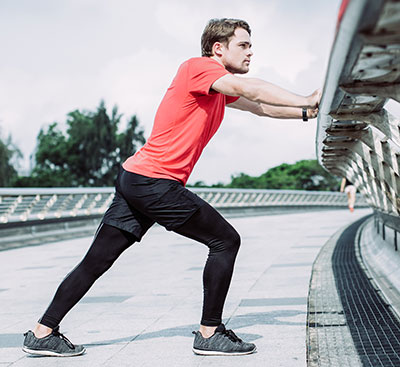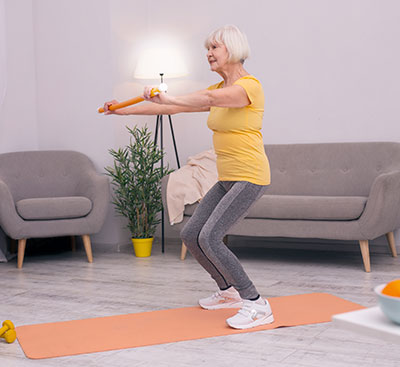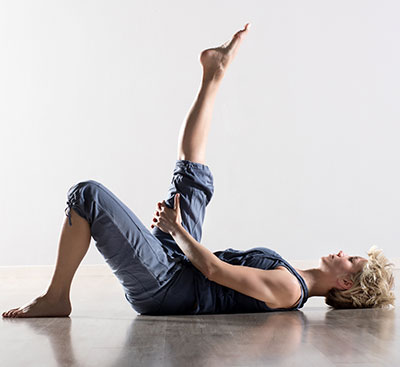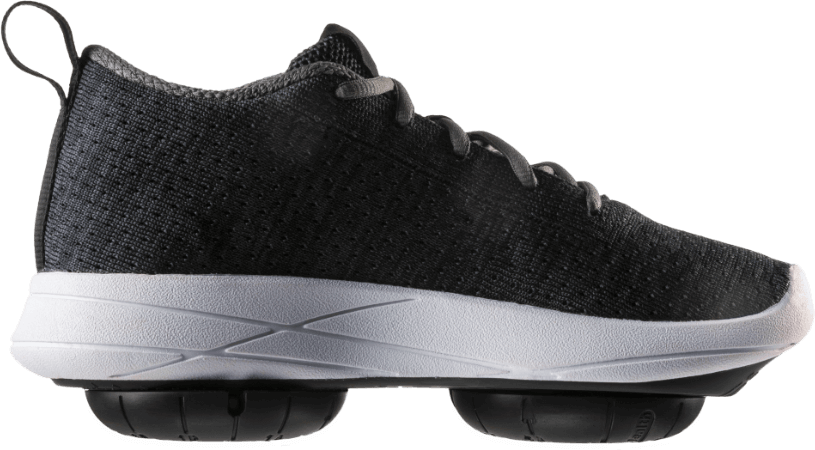When everyday activities make your arthritic knee feel stiff and sore, exercising your knee may seem like the last thing you’d want to do. However, regular exercise can be helpful for managing osteoarthritic knee pain. Studies show that exercise can be a good way to manage pain and improve function.
How does exercise help with knee osteoarthritis?
There are two main types of exercise that can help with knee osteoarthritis: strengthening exercises and stretching exercises. Each is beneficial in different ways.
Knee strengthening exercises work on the muscles that support the knee joint—not the painful knee joint itself. These muscles include the quadriceps in the front of the thigh and the hamstrings in the back. Strong muscles help the knee joint absorb shock and relieve the stress load on the joint—one of the main reasons we experience knee pain. Strong muscles also help stabilize the knee joint and prevent further injury and loss of balance.
Stretching exercises are all about maintaining function and mobility. Stretching helps maintain the knee joint’s full range of motion, and can also help reduce stiffness.
Low-impact exercise for knee osteoarthritis
While exercise is beneficial for knee arthritis, the wrong kind of exercise can exacerbate the condition or even cause further injury. High-impact exercise—in which the feet strike the ground repeatedly and with force—can put shock and strain on the weakened knee joint. These activities include running, jogging, and sports played on a hard surface. Activities that involve sudden twists and turns, such as tennis, also increase the risk of injury to the vulnerable joint.
Gentle, low-impact exercise can be safer for knee osteoarthritis. These activities include walking (in good, supportive, shock-absorbing shoes), swimming, biking and water exercise. Water exercise is often recommended for people with arthritis because the water bears the weight of the body, reducing the impact and load on the joints. At the same time, it is harder to move in water, providing valuable muscle strengthening exercise through resistance.
Check with your doctor or healthcare practitioner about the types of knee exercise that would be best for your specific condition.
6 Basic Exercises for Knee Osteoarthritis
With a go-ahead from your doctor or healthcare practitioner, there are also simple knee exercises for osteoarthritis that you can do at home. These low-impact stretching and strengthening knee exercises don’t require any special equipment.
Standing Exercises
You will need a chair to help you keep your balance. Make sure the chair is sturdy and won’t tip or wobble.
Standing Calf Stretch
- Stand with the feet slightly apart and hold onto a chair back for balance.
- Bend the knee of the left leg and step back with the right. The feet should be in alignment.
- Slowly straighten the back/right leg, pressing the heel into the floor. You should feel the stretch in the calf of that leg.
- When you feel the stretch, hold in place for 20 seconds.
- Switch and repeat with the other leg.
- Start with 2 reps, gradually working your way up to 3.

Hamstring (Back of Thigh) Curls
- This exercise strengthens the back of the thigh to help support the knee joint. It’s very similar to a bicep curl, only with the legs. Start by standing with the feet nearly together, holding onto a chair back for balance.
- Bend the right knee and bring the heel up towards the ceiling as far as you can without pain. Keep the foot flexed and the knees close together.
- Hold for 5 seconds and then lower back down.
- Repeat up to 10 times on the same leg, then switch. Work your way up to 3 sets of 10.
- As you get stronger and the exercise gets easier, you can add ankle weights to the routine. Start with a 1 lb weight and gradually increase in 1 lb increments, up to 10 lbs total.
Half Squats
- This strengthening exercise works the quadriceps, hamstrings and the gluteus (buttocks). Start by standing with the feet shoulder-width apart, holding onto a chair back for balance.
- Keeping the chest up and buttocks tucked under, slowly lower the hips. The movement is similar to lowering yourself into a chair. Go as far as you’re comfortable—this might be only a few inches at first. Try to keep the back straight; don’t lean forward. The feet should be flat on the floor; don’t let the knees go past the toes.
- Hold the squat for 5 seconds.
- Come back up to standing by pressing the heels down, tightening the buttocks as you straighten the knees. Really concentrate on the muscles you’re working.
- Start with 3 reps, gradually working your way up to 10.

Floor Exercises
Lying Hamstring Stretch
- Lie on your back on the floor with the knees bent, feet flat on the floor.
- Lift the right leg off the floor and bring the knee towards the chest.
- Hold the back of the thigh below the knee. If you can’t reach, you can loop a towel, sheet or other sturdy piece of cloth around the thigh, and hold the ends instead. Make sure to grasp below the knee, not directly on it.
- Slowly straighten the leg and pull it gently towards you, until you feel a stretch along the hamstring (back of the thigh). If the leg starts to shake, bend the knee slightly.
- Hold for 30 seconds, then gently release down.
- Switch and repeat with the other leg. Start with 2 reps and work up to 3.

Lying Leg Raise (Back)
- Here is a classic leg exercise that works the quadriceps. Lie on your back on the floor with your upper body propped up on your elbows. The elbows should be directly under the shoulders. Concentrate on keeping your upper body relaxed so your legs can do the work.
- Bend the left knee so the foot is flat on the floor.
- Tighten the quadriceps (top of the thigh) muscles on the right/straight leg. Slowly raise it about 6 inches off the floor. Really concentrate on the thigh muscles working.
- Hold for 5 seconds, then slowly lower the leg down.
- Repeat 10 times before switching to the other leg. Work your way up to 3 sets.
- As you gain strength and the exercise gets easier, you can gradually incorporate ankle weights into the routine.
Lying Leg Raises (Prone)
- “Prone” means lying on your stomach. This exercise is similar to the back lying leg raise, but it works the hamstrings (back of the thigh) and gluteus (buttocks). You will need a pillow for this exercise. Start by lying on your stomach with the pillow under your pelvis, legs out straight, head on your arms.
- Tighten the hamstrings and glutes on the right leg. Slowly raise it towards the ceiling as far as you comfortably can. Make sure to keep the lower back and hips on the floor. Let the leg muscles do the work, not the lower back. Keep the neck relaxed.
- Hold for 5 seconds, then slowly lower the leg down.
- Repeat 10 times before switching to the other leg. Work your way up to 3 sets.
- As you gain strength and the exercise gets easier, you can gradually incorporate ankle weights into the routine.
General Tips for Knee Osteoarthritis Exercise
- Talk with your doctor or healthcare practitioner before starting any exercise program, or before making any changes to one they’ve provided or recommended. If you have any concerns about your pain level or experience an increase in symptoms, check in with them.
- Exercising “cold” increases your chance of injury because the muscles and joints are stiff and inflexible. Warm muscles and joints move more fluidly and easily, helping prevent injury.
Warm up with some light stretches or a gentle 10-minute walk before beginning your exercise routine. The Arthritis Foundation has videos of good warm-up and cool-down exercises you can try.
You may want to wear sweatpants to help keep your joints and muscles warm. You can also use a moist heating pack or pad on your stiff knee(s) about 15 minutes before exercise.
- Wear good, supportive shoes. Even during low impact exercise, they can help absorb the shock of your feet striking or pressing against the ground. This helps protect your joints.
- Exercise is not a competition. Start with the lowest number of repetitions and gradually increase as you gain strength and flexibility.
About 10 minutes of physical activity every other day is good to start, unless your doctor or healthcare practitioner has directed you otherwise. Eventually, you can work your way up to the generally recommended 30 minutes per day of physical activity. If you experience an uptick in your symptoms, you can modify your routine. The goal is to keep active without making your symptoms worse or over-taxing your joints.
- Pay attention to your body. While it’s normal to “feel the burn” in your muscles during stretching and strengthening exercises, you don’t want to overburden or strain your joints. Some mild discomfort is normal, but severe pain is not. Don’t rush through the exercises—really concentrate on the muscles you’re working. This will help isolate the joints from strain and let your muscles do the hard work.
- Don’t abruptly stop moving after your routine. Do some light stretches to cool down. This will help prevent your muscles from tightening up, which can make them more prone to injury.
- If you experience mild pain or swelling after exercise, an ice pack may help prevent and relieve it.
- Some mild soreness the day after you exercise is to be expected. However, you shouldn’t ignore it. Pay attention to your pain level—you don’t want to risk injury and further damage to your arthritic joint(s). If your pain, stiffness and/or swelling is severe and/or increased, stop exercising your knee and check with your doctor before starting again.
AposHealth® can help with treatment of knee osteoarthritis
Earlier, we discussed how joint overload and lack of muscular control can be the underlying causes of knee pain. Physical therapy and AposHealth® are two non-invasive ways of addressing both issues.
AposHealth® is based on an FDA cleared medical device for treating knee osteoarthritis. The AposHealth® footworn device is designed to actually change the point of contact where the foot touches the ground. It unloads the weight away from painful and injured areas of the joints in the legs, pelvis and spine. By retraining the muscles, AposHealth® corrects abnormal walking patterns and is clinically proven to temporarily reduce knee pain42 and improve function42.
You can read more about the AposHealth® program here.
This article is for general educational and informational purposes only and is not a substitute for professional medical advice. Consult with your own healthcare practitioner regarding the use of any information received here before using or relying on it. Your healthcare practitioner should address any and all medical questions, concerns, and decisions regarding the possible treatment of any medical condition.


